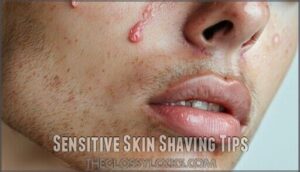This site is supported by our readers. We may earn a commission, at no cost to you, if you purchase through links.
 If you’ve got sensitive skin, shaving every two to three days works best.
If you’ve got sensitive skin, shaving every two to three days works best.
It gives your skin time to heal, reducing redness and irritation. Overdoing it can lead to razor burn or ingrown hairs—nobody wants that!
Use a sharp razor and a good shaving cream designed for sensitive skin. Shave in the direction your hair grows, not against it, to avoid tugging.
And don’t skip moisturizing after—you wouldn’t wash your car without waxing it, right? Small tweaks like these make a big difference in keeping your skin smooth and irritation-free.
Curious how tools and technique can help even more? Keep reading!
Table Of Contents
- Key Takeaways
- Shaving Frequency Matters
- Skin Type Affects Shaving
- Preventing Shaving Irritations
- Choosing Right Shaving Tools
- Post Shave Skin Care Routine
- Sensitive Skin Shaving Tips
- Frequently Asked Questions (FAQs)
- How often should I shave with sensitive skin?
- What is the best shave method for sensitive skin?
- What is the best frequency of shaving?
- How often should I shave to avoid irritation?
- How does environment affect shaving routine frequency?
- What role does diet play in skin sensitivity?
- Can shaving stress impact facial skin health?
- How important is water temperature during shaving?
- Does exercise affect skins shaving requirements?
- Conclusion
Key Takeaways
- Shave every 2-3 days to give your skin time to heal and avoid irritation.
- Use a sharp razor and shave with the grain to reduce redness, razor burn, and ingrown hairs.
- Always moisturize after shaving to lock in hydration and soothe sensitive skin.
- Avoid using dull blades or excessive pressure, and stick to gentle techniques for the best results.
Shaving Frequency Matters
How often you shave can make or break your skin’s comfort, especially if it’s sensitive.
Finding the right balance keeps your skin smooth while avoiding irritation and razor burn.
Hair Growth Rate Impact
Your hair growth rate plays a huge role in deciding your shaving frequency. Quick growth? You’ll likely shave often. Slower growth? You can ease up.
Adjusting for seasons and hormonal changes also helps. Keep these tips in mind:
- Faster growth needs daily or every-other-day shaving.
- Sparse hair suits weekly routines.
- Denser hair requires careful, regular trimming.
- Seasonal changes may impact frequency.
Skin Type Considerations
Your skin type affects shaving frequency more than you’d think.
Sensitive skin needs breaks between shaves to heal. Oily skin can handle more frequent shaves, but dryness relief is key afterward.
Sensitive skin thrives with breaks; shave less often to heal while oily skin can shine with frequent care and moisture.
Average skin? It’s the lucky middle ground.
Winter shaving might demand fewer sessions since dry air affects moisture levels.
Tailor your routine using these sensitive solutions for smoother results to achieve better shaving outcomes with dryness relief.
Personal Style Preferences
Shaving preferences can vary based on your desired look. Whether it’s a clean-shaven look or well-maintained stubble, personal styles shape your shaving habits.
Sensitive skin? Adjust shaving frequency to balance comfort and appearance:
- Maintain stubble with weekly trimming.
- Follow moustache trends by shaping often.
- Try every-other-day shaving for smoother skin.
- Longer beards need shaping every 6-8 weeks.
For a closer shave, consider shaving with the grain. This technique is essential for achieving the look you want while minimizing irritation, allowing you to maintain a well-maintained style.
Skin Type Affects Shaving
Your skin type plays a big role in how often you should shave and how your skin handles it.
Sensitive, oily, and dry skin all have different needs, so understanding yours can help avoid irritation and keep things comfortable, which is crucial for sensitive skin.
Sensitive Skin Needs
If you’ve got sensitive skin, keeping your skin barrier happy is key.
Always hydrate before shaving and use soothing balms after for smoother results.
Look for product ingredients like aloe or glycerin, and try patch testing new products to avoid flare-ups.
For the best shaving sensitive skin strategy, less is more—skip shaving daily to reduce irritation.
Oily Skin Requirements
Ever feel like your face shines brighter than your future?
Oily skin needs extra care when shaving. Too much sebum leads to breakouts and irritation if left unchecked.
Here are tips:
- Cleanse twice daily to control excess sebum and prevent breakouts.
- Use mattifying products to reduce shine and minimize pores.
- Shave every other day for balanced care to achieve a balanced skin.
Dry Skin Concerns
Dry skin needs extra care during shaving.
Use hydrating products with soothing ingredients like aloe vera or shea butter to avoid irritation.
In winter, reduce shaving frequency for sensitive skin.
A lightweight balm locks in moisture post-shave.
Exfoliation methods clear away flaky skin, improving results.
Focus on skin hydration before and after shaving for irritation-free comfort.
Preventing Shaving Irritations
If shaving leaves your skin red or irritated, a few simple changes can make a big difference.
By using the right techniques and tools, you can protect sensitive skin and shave without the worry of razor burn or ingrown hairs.
This approach allows for a more comfortable shaving experience, and by following these steps, you can achieve better results.
Razor Burn Causes
Using dull blades and applying excessive pressure are common culprits behind razor burn when shaving sensitive skin.
Shaving against hair growth or using irritating products can increase skin irritation.
Poor hydration also makes your skin more prone to shaving irritation.
Keeping your skin moisturized and using a fresh blade with a light touch can help prevent discomfort.
Ingrown Hair Prevention
To prevent ingrown hairs, exfoliate regularly to remove dead skin that traps hair.
Shave with the grain, using a sharp blade for a clean glide.
Keep your skin hydrated with a gentle moisturizer to reduce irritation.
Avoid tight clothing after hair removal—it can worsen bumps.
Adjust your shaving frequency for men with sensitive skin to minimize irritation.
Shaving Technique Tips
Mastering shaving techniques for sensitive skin helps you avoid irritation.
Here are three tips to keep it smooth:
- Use short strokes and maintain the right blade angle for a comfortable shave.
- Always follow the grain direction to reduce razor burn and ingrown hairs.
- Focus on lather hydration and apply light pressure for better control and skin protection.
For a smoother shave, consider pre-shave exfoliation techniques to achieve sensitive skin care and a smoother shave.
Choosing Right Shaving Tools
Using the right tools can make or break your shaving experience, especially with sensitive skin.
A good razor, quality shaving cream, and sharp blades work together to protect your skin and keep irritation away, which is a complete concept that encompasses the importance of proper shaving tools for sensitive skin.
Razor Selection Guide
Finding the best razor for shaving sensitive skin is key.
Safety razors are gentle and effective, while electric shavers reduce irritation but sacrifice closeness.
Handle ergonomics matter—comfortable grips prevent slips.
Sharp razor blades minimize tugging, and regular razor maintenance boosts longevity.
For those seeking gentler options, consider exploring razors for sensitive skin.
Compare affordability and effectiveness through cost analysis to choose wisely.
Explore popular shaving razors below:
| Razor Type | Pros | Cons |
|---|---|---|
| Safety Razors | Smooth shave, low irritation | Needs skill to use |
| Electric Shavers | Quick, reduces irritation | Less close shave |
| Cartridge Razors | Convenient, easy to find | Causes more friction |
Shaving Cream Options
Choosing the best shaving cream for sensitive skin is all about the right ingredients and application methods.
Look for sensitive formulas with aloe vera or oatmeal to soothe irritation. Prioritize lather quality—rich creams soften bristles and protect.
Using a brush creates better lather, but hands work too. Many users find relief with specialized sensitive options.
With quality shaving products, sensitive skin shaving feels comfortable and irritation-free.
Blade Replacement Importance
Sharpness matters when shaving sensitive skin.
Dull blades tug at hair, increasing skin irritation and razor burn risk.
Replace razor blades regularly to maintain proper razor maintenance and reduce irritation.
Blade lifespan varies, but aim for 5-10 uses, depending on hair toughness.
It’s a small cost for irritation reduction and smoother shaves, leaving your skin happier and healthier overall, which is crucial for sensitive skin.
Post Shave Skin Care Routine
Taking care of your skin after shaving is just as important as the shave itself.
A good post-shave routine helps lock in moisture, soothe irritation, and keep your skin feeling smooth and healthy.
Moisturizing Essentials
After shaving sensitive skin, moisturizing is a must for maintaining hydration and reducing irritation.
Moisturizing after shaving is essential to hydrate, soothe irritation, and keep your skin feeling smooth, healthy, and refreshed.
Look for products with soothing ingredients like aloe vera or glycerin. Apply moisturizer gently in circular motions, especially at night, to lock in hydration.
Winter skincare demands richer formulas to combat dryness. For the best results, consider using a post shave mist to further soothe the skin.
Remember, shaving and skin moisturising go hand in hand—don’t skip this step!
Exfoliation Benefits
Through gentle exfoliation, you’ll remove dead skin cells that often trap hairs beneath the surface.
Regular exfoliation reduces ingrown hair risk by clearing pores and improving skin texture.
You’ll notice enhanced product absorption as moisturizers penetrate deeper into freshly exfoliated skin.
For sensitive skin, limit exfoliation to once or twice weekly using circular motions, this simple step boosts circulation while creating the perfect canvas for your next shave, resulting in improved overall skin health and skin texture.
Soothing Skin Products
After exfoliating, your freshly shaved skin needs some TLC.
Look for products with aloe vera, chamomile, and shea butter to calm irritation.
Ceramides help rebuild your skin’s natural barrier, while glycerin benefits include deep moisture retention.
For shaving sensitive skin, ingredients like coconut oil and tea tree oil create a protective shield against irritation.
Products with allantoin uses include reducing redness and speeding healing time.
Many people find aloe vera soothing after shaving, which provides deep moisture.
Sensitive Skin Shaving Tips
You’ll find relief for your sensitive skin by shaving every 2-3 days instead of daily, giving your skin needed time to recover between sessions.
Using a sharp razor and shaving with the grain of your hair growth will also substantially reduce redness and irritation that often plague sensitive skin.
Shaving Frequency Guidelines
How often should you actually shave with sensitive skin? For most people with sensitive skin, limiting shaving to 2-3 times weekly provides ideal frequency for skin recovery.
Your personal growth rate and style maintenance preferences matter too. Consider waiting at least 48 hours between shaves, and make seasonal adjustments during winter months when skin tends to be drier.
To prevent irritation, shave with the grain. This balanced approach helps maintain your look while minimizing irritation.
This approach is crucial for skin recovery and overall skin health.
Gentle Shaving Techniques
A perfect shave for sensitive skin starts with lather hydration—soften your stubble with a rich foam.
Use a steady hand to maintain the right blade angle and apply light pressure.
Always follow the grain direction to prevent irritation.
Stick to minimal passes over each area to guarantee comfort while mastering gentle shaving techniques.
Skin Recovery Strategies
After shaving, your skin needs recovery time to heal and feel its best.
Prioritize hydration and repair for a smoother experience with these steps:
- Use a gentle post-shave balm to soothe irritation.
- Try natural remedies like aloe vera for overnight recovery.
- Always apply sun protection to prevent irritation outdoors.
Build a shaving routine that allows your skin to rest, incorporating these practices for optimal results, including the use of gentle products and allowing for rest.
Frequently Asked Questions (FAQs)
How often should I shave with sensitive skin?
Did you know 60% of men with sensitive skin shave every three days to avoid irritation?
To keep your skin calm, stick to 2-4 shaves weekly, use sharp razors, and shave with the grain.
What is the best shave method for sensitive skin?
Use a sharp razor and shave with the grain to prevent burns or bumps.
Apply a gentle shaving cream and hydrate your skin after.
Stick to slow, steady strokes—your skin will thank you, following these steps will help prevent burns or bumps.
What is the best frequency of shaving?
Finding the right shaving frequency depends on your skin and hair growth.
For sensitive skin, every 2-3 days often works best, giving your skin time to heal while preventing irritation.
Listen to your skin’s needs.
How often should I shave to avoid irritation?
Think of your skin like a delicate canvas—shave every 2-3 days to let it recover.
Use a sharp razor, shave with the grain, and hydrate after to keep irritation away.
How does environment affect shaving routine frequency?
Your environment matters when setting a shaving routine.
Humid places might need more frequent shaves due to faster hair growth, while cold, dry climates often mean shaving less to protect sensitive skin from irritation.
What role does diet play in skin sensitivity?
Diet plays a big role in skin sensitivity.
Eating lots of processed foods or sugars can trigger inflammation.
Add more fruits, veggies, and omega-3s to help your skin stay calm, healthy, and less reactive.
Can shaving stress impact facial skin health?
Shaving stress can feel like an uninvited guest, leaving redness, razor bumps, or dryness behind.
It strips your skin’s barrier, increases irritation, and makes it vulnerable.
Gentle techniques and soothing products keep skin healthy and can mitigate the effects of shaving stress.
How important is water temperature during shaving?
The temperature of water can make or break your shave.
Warm water softens hair and opens pores, making shaving smoother.
Cold water after shaving helps close pores and reduce irritation, leaving skin refreshed.
Does exercise affect skins shaving requirements?
When you exercise, sweat and increased skin cell turnover can clog pores, so shaving regularly helps prevent irritation.
Shower first to soften hair and clear sweat—it’s like prep work for smoother, healthier skin.
Conclusion
Finding the best shaving frequency for sensitive skin can feel like cracking the ultimate skincare code, but it doesn’t have to be complicated.
Shaving every two to three days allows your skin to recover, preventing redness and irritation.
Use a sharp razor, a gentle shaving cream, and always moisturize after.
Small details, like shaving with the grain and replacing blades regularly, keep your skin happy, leading to smooth results.
With the right approach, irritation-free results are absolutely achievable. Try it!









